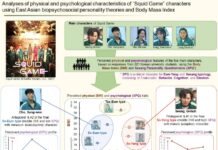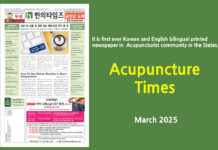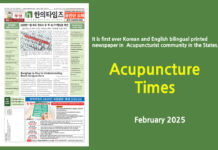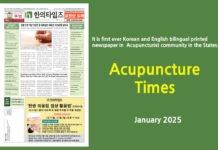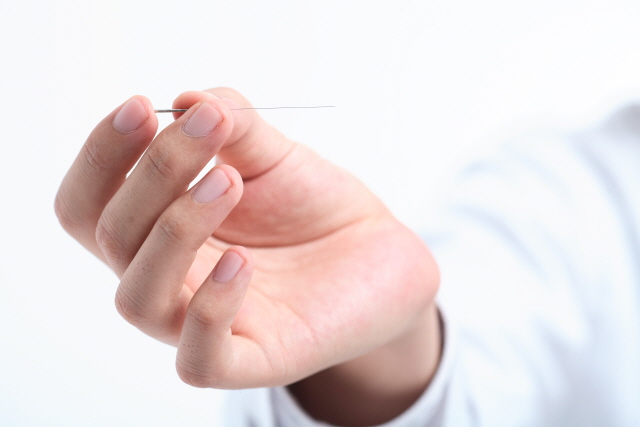- Author: Hyo-Jung Kwon(Department of Acupuncture & Moxibustion, Brain & Neurological Disorders and Pain, Yong-Suk Kim(Kangnam Korean Hospital, Kyung Hee University, Seoul, Korea)
- Copyright © 2015 by authors and Scientific Research Publishing Inc.
2. Method of Acupuncture Treatment
The Five Shu points distal to the elbow and knee correspond to the Five Elements and have been used in clinical treatments depending on each acupoint’s different effects and indication. The combination of Five Shu Points used in Saam acupuncture includes two tonification points and two sedation points. The former, which correspond to the “mother element” according to the law of the Five Elements, tonify the energy of the corresponding channel and Organ. Therefore, the tonification points are needled with stimulation by the tonifying method in Meridian or Organ deficiency conditions.
Each of the 12 Meridians can be subdivided into four types—deficiency, excess, cold, heat—resulting in 48 basic pre-established acupuncture prescriptions, each of which are selections of the Five Shu points. Each Five Shu point corresponds to one of the Five Elements. Traditional use of the Five Shu points incorporates the promotion cycle relationship of the Five Elements where, for example, Wood nourishes Fire and Fire nourishes Earth. As an example, an energy deficiency of the Heart (HT) Meridian (i.e. Fire Meridian) may be corrected by needling on the Wood acupoint (HT9) of the Meridian with a tonification method, based on the above theoretical premise.
In Saam acupuncture, acupoints are also selected using the control cycle relationship of the Five Elements as well. For example, Water suppresses Fire and Fire suppresses Metal. To correct the example of Fire deficiency, the Water acupoint (HT3) of the Fire Meridian should be sedated. Saam acupuncture practice would also simultaneously modulate other relative Meridians selected by the theory of the promotion or control cycle relationships, which is necessary for whole-body balance. In the above example, the Wood acupoint of the relevant Wood Meridian (LR1) should be needled using the tonification method, and the Water acupoint of the relevant Water Meridian (KI10) should be needled using the sedation method.
In deficiency condition, tonify the Mother Element. One should select the Mother Element Five Shu point on the Meridian in question for tonification. For instance, in the case of Lung Meridian deficiency, the Mother Element of the Lung is Earth (Earth is the Mother of Metal), and thus the tonification point of the Lung Meridian would therefore be the Earth point of the Lung Meridian, namely LU9 [7]. In excesses situation, the Child Element on the Meridian in question should be sedated. In the case of the Lung Meridian, the Child Element of the Lung is Water (Water is the Child of Metal), and thus the sedation point of the Lung Meridian would be the Water point on the Lung Meridian, namely LU5. The same principle holds true for the other eleven regular Meridians.
The four needle method [6] consists of the Within-Reinforce-Tonification point and the Within-Reduce-Sedation point, which are tonification and sedation of Gao-Wu [7], as well as the Between-Reinforce-Element point and the Between-Reduce-Element point, which are tonification and sedation among other Meridians. They are used in Saam acupuncture in the same way.
Saam acupuncture makes use of the tonification and sedation points along the promotion cycle as well as points along the control cycle in cases of deficiency and excess; and along the fire and water Meridians in cases of heat and coldness. The basic rules, based on the writings of Nan-Ching [15] [16], are those of the promotion and control cycle relationships. In the case of any Meridian’s insufficiency (weakness), the points of its mother and its own Meridians should be tonified and the points of its governor and its own Meridians should be sedated. In the case of any Meridian’s excessiveness (fullness), the points of its governor and its own Meridians should be tonified and the points of its son and its own Meridians should be sedated [14].
2.1. Example in Deficiencies
- Needle 1: Tonify the deficient Meridian at its mother (tonification) point. With a Lung Meridian deficiency, tonify the Earth point of the Lung Meridian, LU6.
- Needle 2: Tonify the master point on the Mother Element Meridian. With a Lung Meridian deficiency, the Mother of Metal is Earth, hence the Mother of Lung is Spleen, and the master (Earth) point of the Spleen (Earth) Meridian, SP3, should be tonified.
- Needle 3: Sedate the Controller Element on the affected Meridian. With a Lung Meridian deficiency, the Controller of Metal is Fire, so the Fire point on the affected Meridian, LU10, should be sedated.
- Needle 4: Sedate the master point on the Controller Element Meridian. With a Lung Meridian deficiency, the Controller Element is Fire, hence the Controller of Lung is Heart, and the master (Fire) point of the Heart (Fire) Meridian, HT8, should be sedated.
2.2. Examples in Excesses
- Needle 1: Sedate the affected Meridian at its Child Element point. For Liver excess, sedate the Fire (Child) point of the Liver Meridian, LR2.
- Needle 2: Sedate the master on the Child Element Meridian. For Liver excess, the Child of Wood is Fire; hence the Child of Liver is Heart. The master (Fire) point of the Heart, HT8, should be sedated.
- Needle 3: Tonify the Controller Element on the affected Meridian. For Liver excess, the Controller of Wood is Metal, so the Metal point on the affected Meridian, LR4, should be tonified.
- Needle 4: Tonify the master point on the Controller Element Meridian. With Liver excess, the Controller Element is Metal, hence the Controller of Liver is Lung, and the master (Metal) point of the Lung (Metal), LU8, should be tonified.
To summarize the principle for deficiency conditions [19]: Tonify the first two needles—tonify the Mother Element Five Shu point on the affected Meridian, and then tonify the master point on the Mother Element Meridian; Sedate the second two needles—sedate the Controller Element Five Shu points on the affected Meridian, and then sedate the master point on the Controller Element Meridian.
For example, if the Stomach is believed to be hypounderactive: (1) for Fire tonification, Stomach Meridian-Fire point ST41, Small Intestine Meridian-Fire point SI5; (2) for Wood sedation, Stomach Meridian-Wood point ST43, Gall Bladder Meridian-Wood point GB41 should be used. The other Meridians follow the same rule, as described above.
To summarize the principle for excess conditions: Sedate the first two needles—sedate the Child Element
Five Shu points on the affected Meridian, and then sedate the master point on the Child Element Meridian; Tonify
the second two needles—tonify the Controller Element Five Shu points on the affected Meridian, and then
tonify the master point on the Controller Element Meridian.
2.3. Controller Element Meridian
For example, if the stomach is believed to be overactive: (1) for Metal (son) sedation, Stomach Meridian-Metal point ST45, Large Intestine Meridian-Metal point LI1; (2) for Wood tonification, ST43 and GB41 should be used. The Gall Bladder Meridian is opposed to the Stomach Meridian by the control (destructive) cycle of the law of the Five Elements (the governor Meridian), so the Wood point of Gall Bladder Meridian, GB41, destroys the element of Earth within the self-Meridian. The other Meridians follow the same rule described above (Table 3).
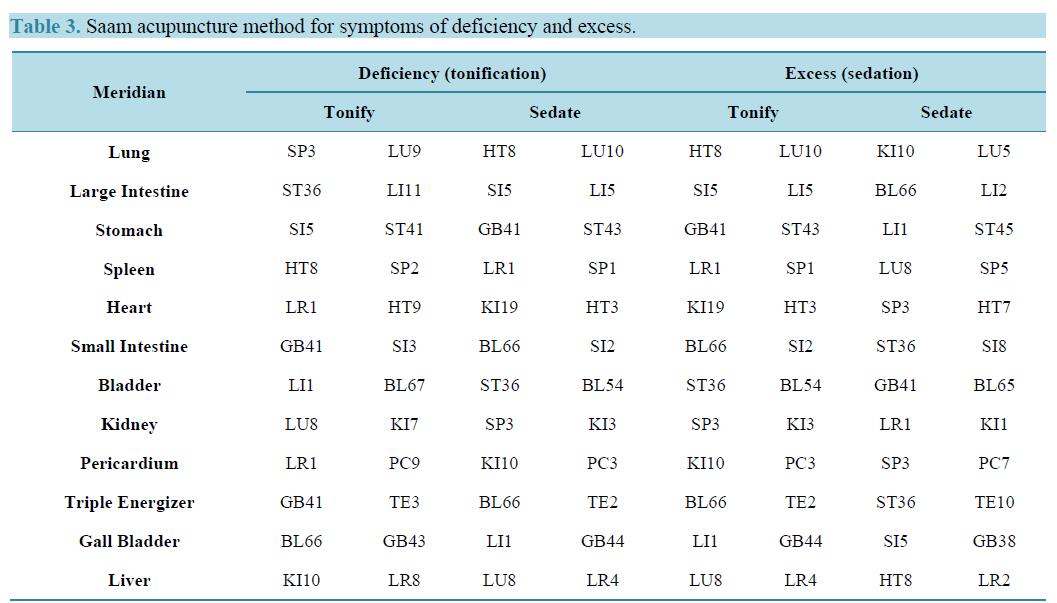
Some kinds of diseases are caused by the imbalance between heat and coldness in the body and the corresponding treatments consist of using the Water and Fire Element Five Shu points along the Meridian in question, the Water Element Meridian, and the Fire Element Meridian. For a heat symptom, the Water point of the self-Meridian and that of the Water Element Meridian are selected to tonify Water, as well as the Fire points of the self and Fire Element Meridians selected to sedate Fire. For a cold symptom, the Fire points of the self and Fire Element Meridians are selected to tonify Fire, as well as the Water point of the self-Meridian and that of the Water Meridians selected to sedate coldness.
In the case of cold symptoms in the Lung, the coldness symptom can be balanced by both the tonification of heat and sedation of coldness. Accordingly, the Fire points, LU10 of the self-Meridian and HT8 of the Fire Element Meridian, should be tonified to warm “coldness.” Conversely, the Water points, LU5 of the self-Meridian and KI10 of the Water Element Meridian, should be repressed. The other Meridians follow the same rules described above.
In the case of heat symptoms in the Lung, the Fire symptom can be controlled by Water, and the Water points, LU5 of the self-Meridian and KI10 of the Water Element Meridian should be tonified. Conversely, the Fire points, LI10 of the self-Meridian and HT8 of the Fire Element Meridian, should be repressed. The other Meridians follow the same rule described above (Table 4).
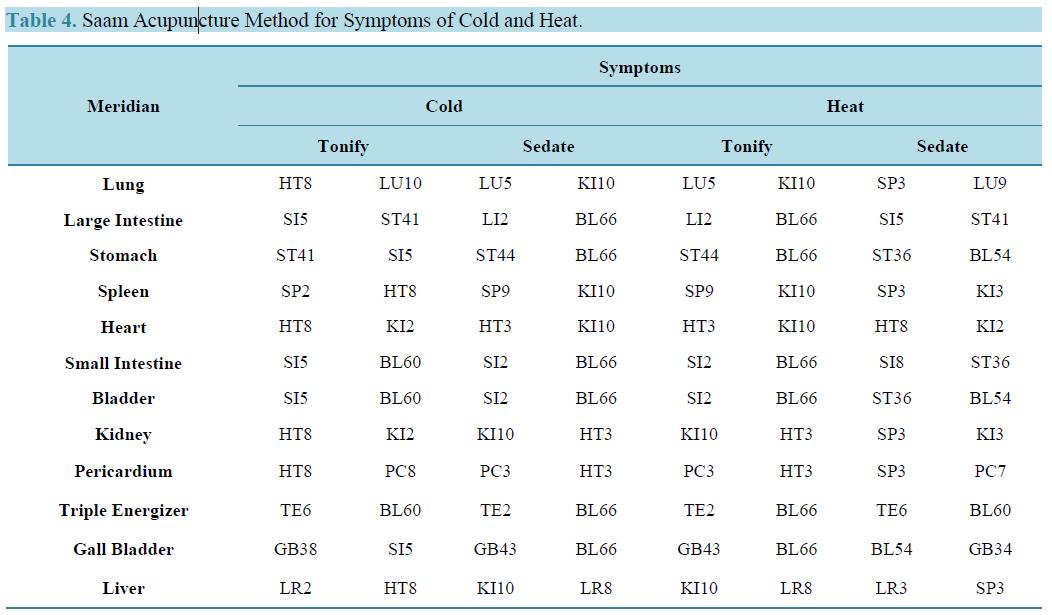
References
[6] Jeremy, R. (2004) Acupuncture Point Combination. Churchill Livingstone, Edinburgh.
[7] Wu, G. (1980) Gatherings from Eminent Acupuncturists-Zhen Jiu Ju Ying. Shinmunfung Publisher, Taipei.
[14] Seem, M.D. (1991) Acupuncture Energetics. Healing Arts Press, Rochester.
[15] Chang, S. (1912) Chiao-cheng t’u-chu pa-shih-i Nan-Ching. Hung-pao chai shu-chu, Taipei, 6-11.
[16] Unschuld, P.U. (1986) Nan-Ching—The Classic of Difficult Issues. University of California Press, Oakland, 474-617.
[19] Kim, D. (2002) Reviewed Sa-Ahm’s Acupuncture Treatment with Graphs. So-Gang Pub, Busan.



